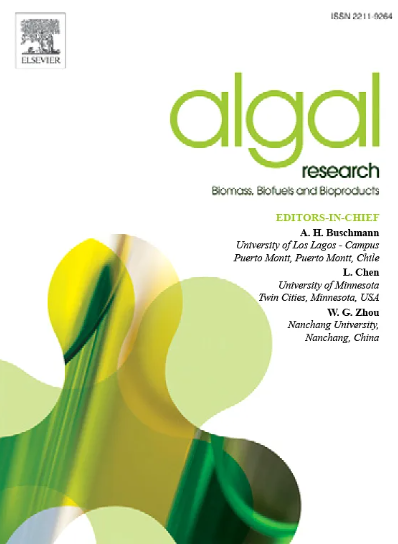IF 4.6
2区 生物学
Q1 BIOTECHNOLOGY & APPLIED MICROBIOLOGY
Algal Research-Biomass Biofuels and Bioproducts
Pub Date : 2025-03-22
DOI:10.1016/j.algal.2025.103997
引用次数: 0
摘要
蓝藻藻华和微塑料(MP)污染已成为日益突出的全球环境问题。本研究调查了聚乙烯衍生有机物(PE-DOM)和聚乳酸衍生有机物(PLA-DOM)对铜绿微囊藻(M. aeruginosa)生长和生理特征的影响。荧光光谱分析显示,聚乳酸有机物(PLA-DOM)和聚乙烯有机物(PE-DOM)都含有促进铜绿微囊藻生长的色氨酸类化合物,其中聚乳酸有机物(PLA-DOM)的此类化合物浓度更高。元素分析表明,两种 MPs-DOM 都提供了藻类生长所必需的微量元素,如 Mg、Na、Ca 和 Zn。两种 MPs-DOM 处理都增加了细胞生物量、叶绿素-a 含量、多糖和蛋白质含量以及过氧化氢酶(CAT)和超氧化物歧化酶(SOD)的活性,同时还改善了光合作用参数。这些结果表明,MPs-DOM 可通过提高营养供应、光合效率和抗逆性来促进铜绿微囊藻的生长。总体而言,铜绿微囊藻在较高浓度的 DOM 条件下生长较好,在 PLA-DOM 条件下生长较好。此外,MPs-DOM 还能增强 mcyB 和 mcyD 的表达,导致微囊藻毒素-LR(MC-LR)的产生和释放,从而促进铜绿微囊藻优势种群的形成。这些发现为蓝藻藻华的形成以及 MPs 污染带来的生态风险提供了新的见解。本文章由计算机程序翻译,如有差异,请以英文原文为准。

Colony formation of toxic Microcystis aeruginosa affected by microplastics-derived organic matter
Cyanobacterial blooms and microplastic (MP) pollution have become increasingly prominent global environmental issues. This study investigated the effects of polyethylene-derived organic matter (PE-DOM) and polylactic acid-derived organic matter (PLA-DOM) on the growth and physiological characteristics of Microcystis aeruginosa (M. aeruginosa). Fluorescence spectroscopy revealed that both PLA-DOM and PE-DOM contained tryptophan-like compounds that promoted the growth of M. aeruginosa, with PLA-DOM exhibiting higher concentrations of these compounds. Elemental analysis indicated that both MPs-DOM provided essential trace elements such as Mg, Na, Ca, and Zn, which are crucial for algal growth. Both MPs-DOM treatments increased cell biomass, chlorophyll-a content, polysaccharide and protein contents, and the activities of catalase (CAT) and superoxide dismutase (SOD), while also improving photosynthetic parameters. These results suggest that MPs-DOM foster M. aeruginosa growth by enhancing nutrient availability, photosynthetic efficiency, and stress tolerance. Overall, M. aeruginosa showed better growth at higher concentrations of DOM and better growth under exposure to PLA-DOM. Furthermore, MPs-DOM enhanced the expression of mcyB and mcyD, leading to the production and release of microcystin-LR (MC-LR), which promoted the formation of dominant M. aeruginosa populations. These findings provide new insights into the formation of cyanobacterial blooms and the ecological risks posed by MP pollution.
求助全文
通过发布文献求助,成功后即可免费获取论文全文。
去求助
来源期刊

Algal Research-Biomass Biofuels and Bioproducts
BIOTECHNOLOGY & APPLIED MICROBIOLOGY-
CiteScore
9.40
自引率
7.80%
发文量
332
期刊介绍:
Algal Research is an international phycology journal covering all areas of emerging technologies in algae biology, biomass production, cultivation, harvesting, extraction, bioproducts, biorefinery, engineering, and econometrics. Algae is defined to include cyanobacteria, microalgae, and protists and symbionts of interest in biotechnology. The journal publishes original research and reviews for the following scope: algal biology, including but not exclusive to: phylogeny, biodiversity, molecular traits, metabolic regulation, and genetic engineering, algal cultivation, e.g. phototrophic systems, heterotrophic systems, and mixotrophic systems, algal harvesting and extraction systems, biotechnology to convert algal biomass and components into biofuels and bioproducts, e.g., nutraceuticals, pharmaceuticals, animal feed, plastics, etc. algal products and their economic assessment
 求助内容:
求助内容: 应助结果提醒方式:
应助结果提醒方式:


